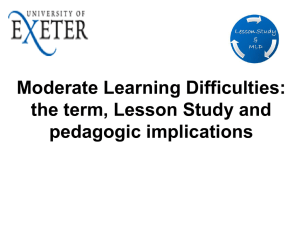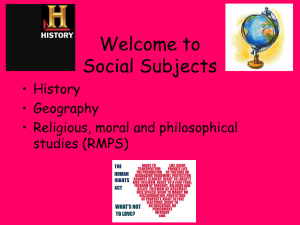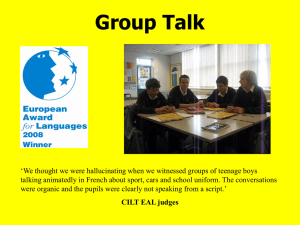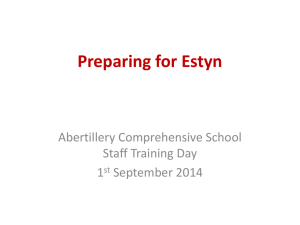Moderate learning difficulties
advertisement
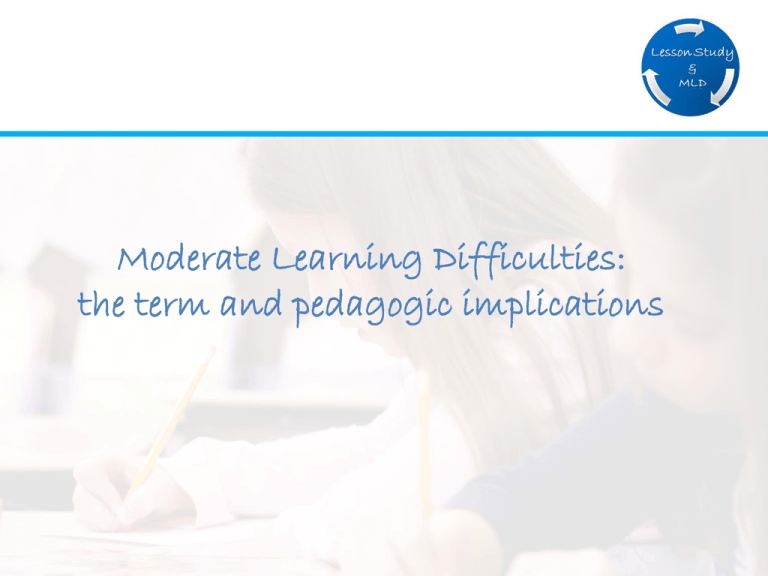
Moderate Learning Difficulties: the term and pedagogic implications Rationale for study - pupils with moderate learning difficulties (MLD) represent the largest proportion of those identified as having special educational needs in the school system, - neglected as a focus for educational initiatives. - 25% of all pupils identified as having SEN at school action plus or with Statements in ordinary and special schools - neglect attributed to several factors. – come disproportionately from families who experience socio-economic disadvantage – no well established advocacy or voluntary group dedicated to the interests of these pupils – historic uncertainty about pupils with MLD : between those with severe intellectual disabilities and ‘normal’ pupils who are lower attaining – historic uncertainty about pupils with MLD between those with severe intellectual disabilities and ‘normal’ pupils who are lower attaining British Education Index Search: References found by ‘title and abstract’ search for: Moderate LD 35 Specific LD 65 Dyslexic/ia 403 Autism/ic 450 Behaviour difficulties 74 Emotional difficulties 176 Moderate learning difficulties 1. Not low attainment – not severe intellectual disability 2. Traditionally defined in IQ terms : 50/55-70 range 3. Subject to much critique – ethnic / cultural bias/ use of IQ; intelligence tests 4. Terminology changes/sensitivity: Mental deficiency, Educational imbeciles, Feeble minded, Mild /moderate educational subnormal, Educational mentally retarded, Mild/moderate intellectual disability 5. Terms and meaning vary internationally 6. Socially constructed term – serving dominant interests 7. Raises questions about : what is special education, who needs it? 8. Acid test’ of inclusion policies. Moderate learning difficulties Pupils with moderate learning difficulties will have attainments significantly below expected levels in most areas of the curriculum, despite appropriate interventions. Their needs will not be able to be met by normal differentiation and the flexibilities of the National Curriculum. They should only be recorded as MLD if additional educational provision is being made to help them to access the curriculum. Pupils with moderate learning difficulties have much greater difficulty than their peers in acquiring basic literacy and numeracy skills and in understanding concepts. They may also have associated speech and language delay, low self-esteem, low levels of concentration and underdeveloped social skills.” (DfES, 2003) Statistics on MLD at SA+ and Statement in ordinary and special schools (2008 DfE stats) MLD % of all with SEN Numbers Primary SA+ 30.4* Primary Statement 13.5*** Primary Total 27.2* Secondary SA+ 27.1** Secondary Statement 23.6* Secondary total 26.2** Special SA+ 4.9 Special Statement 23.3** (after SLD) Special total 22.9** (after SLD) Total SA+ 28.9* 127,880 Total Statement 20.7* 44,100 Total overall 26.2* 171,960 (after SLCN, ASD) (after BESD) (after BESD) * highest %; ** 2nd highest %; *** third highest % Table 1: Crowther et al. (2001) system for defining MLD Associated with No other significant difficulties Significant emotional and behavioural difficulties Significant sensory/medical difficulties Milder learning difficulties More severe learning difficulties Figure 1: Concept map of themes in LEA definitions’ of MLD term not use term low cognitive ability associated difficulties not SLD nor SpLD MLD specify cut-off low attainment and ability low attainment cross curriculum Desforges (2006) review: “achievement of pupils with MLD at Key stage 3 and 4, these pupils underachieve radically” DCSF statistics 2009, Achieving 5ACEM: 50.7% overall 16.5% with SEN 2008 Achieving KS2 Level 4+ Eng and Maths: 84.6% overall 33.7% SEN DCSF (2010) % of pupils with Statements/SA+ in each areas of SEN achieving level 4+ in Eng and Maths % numbers Specific LD 22.7 9,042 Moderate LD 11.1 19,480 Severe LD 21 2,410 Beh, Emot Soc D 36.2 12,116 Visual Impairment 52.5 652 3 prototypes (LA use) : 1. definitions in terms of low curriculum attainments (all / a number), with cut-offs specified and with associated areas of difficulties; 2. definitions in terms of low attainments AND cognitive abilities, with cut-offs specified, distinguished from severe and specific learning difficulties and with associated areas of difficulties; 3. not use MLD term. Is there a difference between MLD, low attainment and specific learning difficulties SpLD? - depends on definition: attainment only OR attainment AND cognitive ability - MLD as general learning difficulty; SpLD as specific difficulty - categoric versus dimensional (continuum position) - dimensional with pragmatic cut offs Specific – general learning difficulties uneven even Specific General LD: MLD LD Range of attainments MLD low attaining average attaining high attaining Why use the term MLD? Is it a disability, like severe learning difficulties? Or is it just very low attainment? - Raises dilemma about differentiating this group 1.If do we identify MLD as an area of SEN / disability? Risks – negative labelling, false identification ad disability/SEN 2. If do we not identify it as difficulty / disability but as part of the continuum of attainment? Risks – overlook rights / needs of some vulnerable pupils, lose additional resources 3 options for resolving dilemma: 1. Retain and specify MLD category as an area of SEN 2. Abandon MLD as a SEN category: consider as very low attainment provide in terms of compensatory education / social inclusion framework. 3. Abandon MLD for majority, redefine new tighter category of mild mixed difficulties for minority. What positive difference does this make for teaching? Is there a specific set of MLD relevant teaching strategies? - Little research; what written suggests no MLD specific pedagogy teaching (Fletcher-Campbell, 2004) - various teaching approaches relevant to MLD but also relevant to pupils with lower attainment - Continua of pedagogic strategies: appropriate teaching as intensification / more focussed extension of general teaching approaches Lesson Study methodology components: -developing ground rules for working in joint research mode, • using case pupils (small number of pupils around whom the development is focussed), • identifying what to learn and why; the research focus, • drawing on what has been learned already about this focus, • joint planning, • joint observation (data capture) • analysing and recording of what has been learned from case pupils and by researchers, • capturing and distilling practice / data (through using videos, stills and audios) • finding ways of helping others to learn from what has been learned (innovated, refined, modified), •creating an artefact to communicate this (e.g. powerpoint, video, coaching guide, etc.) and using it. What do we know about focus on MLD that is relevant to Lesson Study developments? •traditional assumption is that there are weaker intellectual abilities; reasoning, problem solving, thinking skills etc. • one way forward is to adopt a thinking skills scheme to inform the developments using Lesson Study • this line pursed in research in other countries: Dr Pang (Hong Kong University) Thinking skills (National Curriculum) 1. Information processing 2. Reasoning 3. Enquiry 4. Creative thinking 5. Evaluation Thinking skills (National Curriculum) Information processing •sort and classify •compare and contrast •analyse part/whole relationships Creative Thinking •generate and extend idea •suggest hypotheses •look for alternative, innovative outcomes Reasoning •give reasons for opinions and action •draw inferences and make deductions •make informed judgements and decisions Evaluation •evaluate information •judge the value of what they read, hear and do •develop criteria for judging the value of work or ideas Enquiry •ask relevant questions •plan what to do and how to research •predict outcomes and anticipate consequences •test conclusions and improve ideas Teaching strategies: 1. Advance organisers 2. Analogies 3. Audience and purpose 4. Classifying 5. Collective memory 6. Living graphs 7. Mysteries 8. Reading images 9. Relational diagrams 10. Summarising Leading in Learning The Strategies National Curriculum Thinking Skills Information Processing Evaluation Creative thinking Reasoning Enquiry 1 Advance organisers 2 Analogies 3 Audience and purpose 4 Classifying 5 Collective memory 6 Living graphs and fortune lines 7 Mysteries 8 Reading images 9 Relational diagrams 10 Summarising The 3-Lesson Model Planning Review 1st Lesson Planning Observation, video, meeting, interviewing pupils, reading learning logs Review 2nd Lesson Planning Observation, video, meeting, interviewing pupils, reading learning logs Review 3rd Lesson 22 Thinking skills and Lesson Study in your subject • What opportunities are there in the lesson you are focusing on in Lesson Study to integrate some relevant thinking skills? • Will this integration of specific thinking skills in the lesson planning for and teaching of the Pupil/s with identified MLD help to raise their and others’ attainment? 23 ARCS model: expectancy – value model ATTENTION - perceptual arousal - inquiry arousal - variability /novelty RELEVANCE - goal orientation - motive matching CONFIDENCE - learning requirements - success opportunities - personal responsibility SATISFACTION - intrinsic reinforcement - extrinsic rewards - equity Motivation strategies ARCS model (Keller) • Design guidelines for developing effective motivational strategies • Attention • Relevance • Confidence • Satisfaction Motivational observation/interviewing schedule: Based on areas arising from Motivation Survey based on ARCS (focus on individual and/or group) Arousal / attention: i. Shows initial interest in lesson ii. Interest retained during lesson iii. Shows curiosity for aspects of lesson iv. Retains attention through variety of activities v. Repetition and practice leads to boredom vi. Content of lesson too hard /challenging to maintain attention Relevance i. can relate activity / lesson to personal interests/ experiences ii. understands how activity / lesson relates to learning goals / targets iii. sees the point / purpose of lesson for longer term personal gaols Confidence: i. shows confidence about doing the activities ii. believes that s/he can cope with activities iii. communicates about difficulties / challenges of learning iv. takes control of learning activities Satisfaction: i. enjoyed activity so much that wants to do more ii. shows that working at activity is worthwhile iii. shows pleasure during the activity / lesson iv. experiences satisfaction when activity completed Motivation strategies and Lesson Study in your subject • What opportunities are there in the lesson that you are focusing on in Lesson Study to integrate teaching that promotes motivation strategies? • Will the integration of specific motivation strategies in lesson planning for pupil/s with identified MLD help to raise their and other pupils’/students’ motivational attainments?
